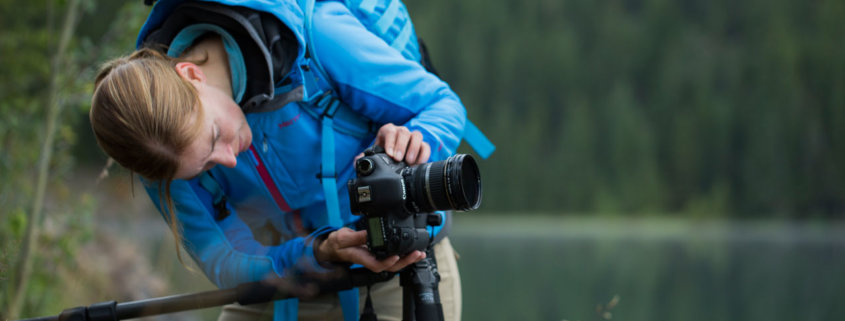How to Clean Your Photography Tripod
It’s extremely important for landscape photographers to clean their photography tripod now and then. We try to clean ours about twice a year – more often if we’ve been photographing in sand, salt water, or swamps. Grains of sand can work their way into the grooves and threads of your tripod. You’ll know it’s time to start scrubbing if you hear a grinding or grating sound as you turn the knobs or make adjustments to the tripod. Salt water can corrode some metals – so you should rinse your tripod after shooting at the beach. And swamp water – well, the bacteria that grows in swamps can climb right into your camera tripod legs and just hang out there… multiplying happily until you open your tripod and discover that it really stinks! Cleaning a photography tripod isn’t particularly difficult… though it can take some time. It takes about an hour to completely clean both of our carbon fiber tripods.
Disassemble your Camera Tripod
The first step is to take the camera tripod apart. Each tripod will be different. Jay and I both have Induro & Benro Carbon Fiber Tripods, but they are different models, and the parts are slightly different. However, since they both have twist lock leg mechanisms, they come apart in the same way. We loosen them the same way we would if we wanted to extend the tripod leg segment, and then we keep on twisting in the same direction until the camera tripod leg detaches. Locking clips will require a different set of steps – some have removable screws, and some are held in place by pins that are not removable. If your photography tripod doesn’t come apart, don’t sweat it. You can still clean your tripod. We’ll get to that in a minute.
The important thing is to keep track of where all those little pieces go, so that you can put it all back together when you are done. If you are worried about putting the photography tripod legs back together, take some photos for reference as you work. You may find that there are more pieces than you expected. This photo shows Varina’s Induro tripod, all taken apart. Notice that we didn’t remove the screws that hold the top of the tripod legs to the center piece. We find that they don’t usually need to be removed for cleaning.
Use soap and water to clean every piece
Once our carbon fiber tripod is in pieces, we fill up the sink with hot, soapy water and get down to business. We use dish soap to clean each piece by hand. There’s no particular brand that we recommend – but do use dish soap, since it cuts through grease and won’t leave a residue. I use a soft scrubbing pad to clean each part, and an old toothbrush to get the threads in the tripod legs clean. Generally, I keep a small bowl of dish soap handy. I dip my toothbrush into it now and then so that I can get through the grease. Scrub the threads carefully to remove any grease that is stuck in there… along with sand, silt, and slime. :) Then a quick rinse, and we lay it all out on a cloth to dry.
Keep in mind that rough-cut edges of metal or carbon fiber can give you splinters! Our carbon fiber tripods tend to lose tiny, sharp shards from the ends of the leg segments. I pulled two out of my fingers the last time I cleaned my photography tripod. Ouch! You can wear rubber gloves to protect your skin. They’ll keep the grease off your hands and keep your fingers from getting all wrinkly, too. :)
If your camera tripod doesn’t come apart, just flush out each joint on the tripod legs with hot, soapy water. You can use a small brush to get into the little grooves and openings to clean them out as well. Adjust your locking clips and slide the tripod legs in and out under sudsy water if you can. That will help to loosen any grit that is trapped in tight places. You should be able to get your camera tripod pretty clean that way. Extend all the tripod legs and allow it to dry thoroughly before putting it away.
Dry and reassemble your tripod
Once the pieces are clean and dry, it’s time to put the tripod back together. You need to use a small amount of lithium grease on the threads of your tripod legs to keep everything working smoothly. This photo shows how much we use.
A little goes a long way – and if you put too much, you’ll just end up having to wipe it off later. We put a little bit of grease on the threads of our carbon fiber tripod legs and then screw the tripod leg segments into place slowly – screwing them in and out a bit as we go to help spread the grease around. The pieces should turn smoothly… if you hear a gritty grating sound as you put the pieces back together, check for debris in the threads. You may need to do a better job cleaning. You’ll need grease in all the moving parts – there’s no need to grease screws that should remain tight.
Wipe off any excess grease with a paper towel, and you’re done with cleaning your photography tripod! Now, that wasn’t so bad, was it!? :) Here’s a quick video that shows the whole process:
The frequency with which you’ll need to clean your camera tripod depends upon how you use it. If it never leaves the house, you probably don’t need to clean it at all. If you are shooting on the grass or a muddy path – just rinse the feet when necessary and you’re good to go. Rain won’t hurt your camera tripod – though prolonged exposure to moisture will corrode some metals… so take the time to dry it off when you come in and leave it open until it’s thoroughly dry. Always rinse your tripod if you use it in salt water – salt can cause corrosion as well.
Take simple precautions to help keep your photography tripod clean a little longer. When we are shooting in sand, mud, or water, we always extend the lowest leg of the camera tripod at least a few inches beyond the mess. That simple action keeps the joint up out of the muck. If you can avoid it, don’t immerse the joint in sand or salt water. But don’t worry too much if it does get into the joints. Just take some time to clean it up and it’ll be good as new!












I always carry a soft cloth and some WD40 or G96. When my tripod gets soaked I end up by spraying all the parts, since these products are moisture dispersants. I then dry with the cloth. Nothing works better, since it also lubricates.
For things in your bags, I always try to be safe but “it” just might happen. You reminded me about medical things. Thanks.
As a favor, try this. Carry a cheap toothbrush.
Should you happen to drop or bounce your equipment in or on dirty or muddy things, the cloth you talked about will do most of the cleanup but a toothrush will get in and around the tiny parts of your camera and around the lens seat before you swap lenses.
The lens brush you mentioned is too soft. Besides, you really don’t want to use a “muddy” brush to clean the glass.
(Please don’t ask how I found that out.) LoL
Good advise on the tooth brush. There were times when I wished I had one. I wont ask this time…but can I guess? Dog poop?
That’s sickening! Thank goodness your guess was wrong Jay!
Having setup for a wireless remote shot about 200 yards away, I noticed one of the tripod’s legs beginning to sink. Arriving a few minutes too late, I ended up with regular ‘ol mud on the right half on my camera and lens.
Never got a shot either. Only a bunch of mud!
Hey! I just thought of something you could market. On construction cranes they have those big outrigger pads to hold the machine from falling over. You could make a much smaller version to place on the bottom of a tripod. I even thought of the name of it. Call it the “Patel Pad”.
Thank you for very useful information. I was afraid of cleaning tripod with soap. Because soap will remove all lube. Then you show how to reapply grease on it. Great information.
I’m so glad this post was useful to you!
Nice tutorial Varina & Jay. BTW the little splinters,…Carbon Fiber is not a metal, it is a fiber, like cloth that is reinforced with an epoxy/resin matrix. It is lighter than aluminum with the strength and stiffness of steel. The splinters are cured carbon flakes and they can be very sharp so being careful around the edges is a real good idea. And if you do get a splinter in a finger do get it out, the splinters tend to cause a kind of mechanical dermatitis.
Thanks for very useful information. I knew that the carbon fiber were resin, but was not sure what else it was mixed with.